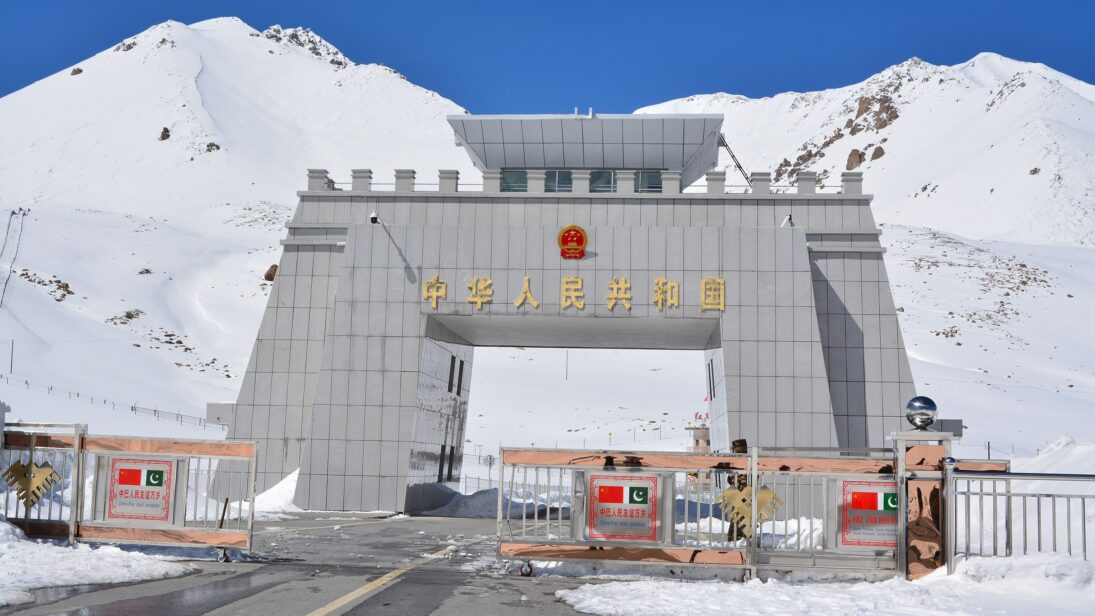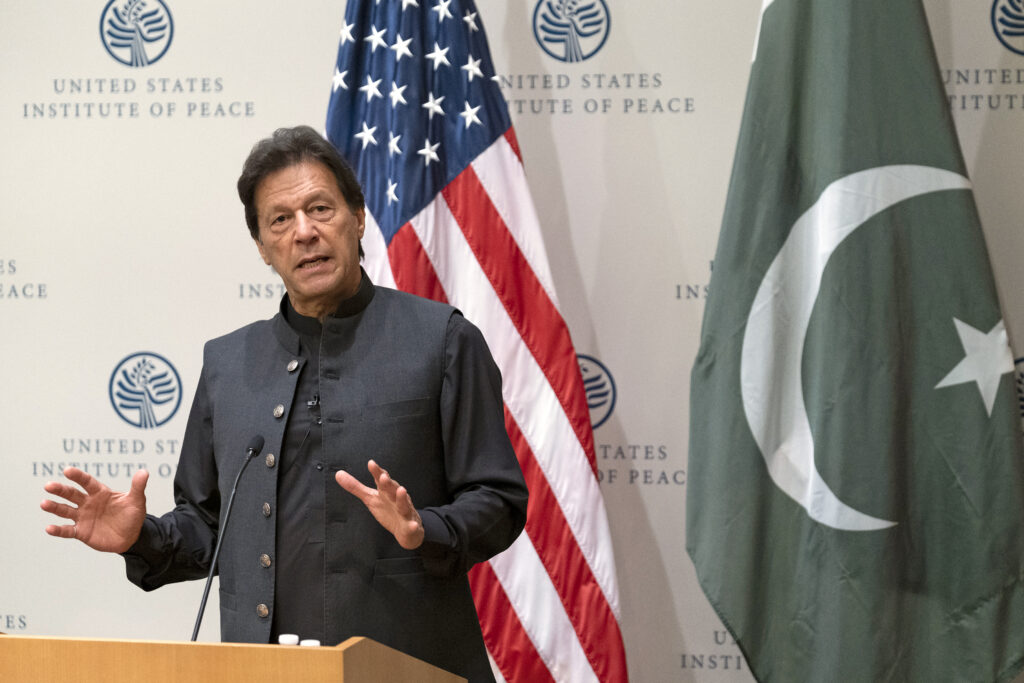
As great power competition between the United States and China intensifies, states are scrambling to position themselves within the rapidly-shifting world order. Pakistan is faced with the same predicament, and its foreign policy remains largely defined by relations with the United States and China. For now, there has been no indication that Pakistan will have to exclusively side with either power, but how long can Pakistan maintain this tenuous position?
Despite Pakistan indicating in the recently launched National Security Policy (NSP) that it does not want to be part of “camp politics,” deepened economic cooperation illustrates a steady drift towards China, best exemplified by the establishment of the China Pakistan Economic Corridor (CPEC) in 2015. Meanwhile, Pakistan’s historically wavering relations with the United States remain at a standstill. The U.S. withdrawal from Afghanistan raised serious questions about the future of the bilateral U.S.-Pakistan relationship, as the major focus of communication between the two states has historically been Afghanistan.
Although Pakistan enjoys a growing trade relationship with China, the United States remains Pakistan’s largest trading partner. Pakistan also remains heavily dependent on U.S. military hardware and the U.S. export market. Therefore, while relations with China are deepening, Pakistan cannot afford to alienate the United States and discourage economic investment and security cooperation. Pakistan must avoid the natural tide that is pulling the country towards China and attempt to revive its relationship with the United States, maintaining its strategic autonomy for as long as possible. There is a limited window of opportunity for Pakistan to revisit its relations with the United States and rebuild the trust deficit before U.S.-China tensions escalate. Islamabad policymakers will need to identify feasible opportunities for bilateral cooperation beyond counter-terrorism and security that could include economic initiatives, scientific collaboration, and technological innovation, focusing on people-to-people connections, reaching out to the U.S. based Pakistani diaspora, as well as reassessing Pakistan’s economic policies to attract foreign investment.
There is a limited window of opportunity for Pakistan to revisit its relations with the United States and rebuild the trust deficit before U.S.-China tensions escalate.
The Stakes of the China Drift
Three recent circumstances have contributed to pulling Pakistan closer to China and driven disengagement with the United States. First, the United States’ withdrawal from Afghanistan presents a major shift in Pakistan’s bilateral relations with the United States. For the last two decades, relations have been largely defined by the security situation in Afghanistan which provided opportunity for cooperation, but also limited the scope of bilateral relations between the two countries. In this context, decreased U.S. involvement in Afghanistan may also imply decreased engagement with Pakistan.
Pakistan’s inclusion in Financial Task Force (FATF) grey list has also strained relations with the United States and pushed Pakistan closer to China. In June 2018, Pakistan was added to the FATF for inadequate controls to deter terrorist financing and money-laundering. Being added to the grey list has had serious implications for Pakistan’s banking sector and served as a signal to the global financial community, making it difficult for Pakistan to access foreign capital. Economic assistance from China has since been Pakistan’s major external source.
Lastly, growing U.S. defense cooperation with India disrupts South Asia’s regional balance and stability. Pakistan’s relations with India have long been marred by hostility and distrust. Increased defense cooperation between India and the United States especially the Basic Exchange and Cooperation Agreement (BECA), the last of four foundational defense agreements, rang alarms in Islamabad. For Pakistan, friendship with China provided much-needed external support neutralizing the regional balance of power that has tilted in favor of India.
In the absence of active and sustained engagement with the United States, Pakistan is becoming overly reliant on China. A stable relationship with the United States, however, could provide Pakistan with the strategic space to maneuver and leverage its position with both great powers. China’s ability to exert influence on Pakistan’s economy has grown substantially in recent years, mainly due to the fact that China is now Pakistan’s largest creditor. In June 2013, Pakistan’s total public and publicly guaranteed external debt stood at USD $44.35 billion and only 9.3 percent of this was owed to China. According to the IMF, the external debt had grown to $90.12 billion by April 2021, with Pakistan owing 27.4 percent ($24.7 billion) of its total external debt to China. Though China has so far refrained from directly influencing Pakistan’s economic policies, proponents of Pakistan-China alliance often underestimate this “interest based” nature of China’s relations with Pakistan. There is no guarantee that Pakistan’s decisions in the future would not stem out of China’s greater interests in the region.

Policy Considerations
As Pakistan increasingly tilts towards China, it is unclear how long it can maintain beneficial relationships with both great powers. Pakistan must revive its relationship with the United States to maintain some level of strategic ambiguity. If these actions are successful, Pakistan may be able to use its unique position at the center of competition between the great powers to garner investment and economic support from both the U.S. and China. For that, a direct engagement with U.S. policymakers can prove valuable and allow both countries to address their concerns and highlight areas for future cooperation.
Pakistan will also need to address how to shift its security-centric relationship to one driven by economic cooperation, scientific collaboration, and technological innovation. It is important that Pakistan moves the bilateral relationship beyond government-to-government to foster deeper people-to-people connections. Pakistani-American entrepreneurs, venture capitalists, investment bankers, accountants, lawyers, and advisers make up a growing ecosystem in Silicon Valley. Pakistan has huge potential to expand as a digital economy and must leverage its dynamic diaspora to influence non-security relations with the U.S. American companies and the U.S. government also see South and Southeast Asia as a major opportunity for supply-chain reorganization and investment. With a 220 million population, over 64 percent under the age of 30, Pakistan must brand itself in this way, emphasizing its low labor costs. Domestically, Pakistan can look for ways to diversify and privatize its economy to encourage entrepreneurs and attract opportunities and investment from the United States.
As Pakistan increasingly tilts towards China, it is unclear how long it can maintain beneficial relationships with both great powers.
To preserve space for U.S. cooperation it is important that Pakistan alleviates concerns about its commitment to democratic principles and adheres to FATF guidelines. So far, Pakistan has addressed 30 out of 34 items for two concurrent action plans and to accelerate its removal from FATF grey list, Pakistan will need to continue to take steps to address the remaining action plan items. Being taken off the FATF grey list could also help bring in more involvement from the United States economically, which may send encouraging message to the European countries as well.
CPEC is one of the leading concerns from U.S. policymakers on the depth of Pakistan-China ties. Identifying ways to assuage these concerns will be of utmost importance, however, this remains sensitive issue for Pakistan. Renegotiating CPEC deals to reach a balanced approach between the United States and China is unlikely to succeed and would cause serious domestic backlash and pushback from China. Instead of taking drastic measures to alleviate U.S. concerns about CPEC, Pakistan can use public statements and U.S.-Pakistan bilateral engagements to demonstrate that China’s investments and CPEC loans do not facilitate China’s strategic depth in the country. Even the United States itself and multilateral institutions like World Bank and Asian Development Bank (ADB) have identified revival of the “old silk route” as potentially valuable. These imperatives provide the rationale for Pakistan’s overall approach regarding CPEC to be guided by economic rather than strategic objectives, specifically for the goal of supporting geo-economic activity in the region and developing a sustainable economy for Pakistan. Framing CPEC as an attempt to bolster Afghanistan’s trade with other countries may also help ease Western apprehensions about Chinese investment.
The Path Forward
While Pakistan’s relationships with the great powers appear increasingly contradictory, there have been no explicit demands for an exclusive partnership from either Beijing or Washington. China’s expectations of Pakistan are likely to grow significantly in the near future, especially if Pakistan becomes economically dependent on China. Unfortunately, if the standstill in U.S.-Pakistan relations continues, fears in U.S. policy circles of Pakistan being swayed by China may naturally become a reality. This is an important situation for Pakistan’s leaders to discuss with American policymakers, potentially compelling U.S. leaders to maintain a mutually beneficial relationship with Pakistan.
So far, Pakistan has not been a main arena of U.S.-China competition. It need not become so, specifically if the country takes effective steps to improve bilateral relations with the United States and retain its autonomy in the growing ties with China. In the long run, Pakistan must avoid sabotaging chances of reconciliation with the United States or undermining its relations with China, continuing to cooperate with both the U.S. and China in the larger interest of regional peace and security.
***
Click here to read this article in Urdu.
Image 1: Nain Malik via Wikimedia Comms


